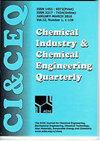Modeling and simulation of the biosurfactant production by enzymatic route using xylose and oleic acid as reagents
IF 0.8
4区 工程技术
Q4 CHEMISTRY, APPLIED
Chemical Industry & Chemical Engineering Quarterly
Pub Date : 2022-01-01
DOI:10.2298/ciceq210621001c
引用次数: 2
Abstract
The biosynthesis of sugar esters, molecules with biosurfactant properties, can occur through the esterification of sugars with fatty acids by enzymatic catalysis. An alternative to reduce the impact of raw materials on the final cost of biosurfactant production and reuse industrial waste is to use residues from vegetable oil industries as source of FFA (Free Fatty Acid, such as oleic acid) and lignocellulosic residues of 2G ethanol as source of sugar (xylose). In this scenario, the present work aimed to model the production process of biosurfactants via heterogeneous biocatalysis by lipase, using oleic acid and xylose. Product separation and purification was performed using a sequence of precipitations (by adding ethanol, water and methyl ethyl ketone). Simulation was performed using the equation-oriented software EMSO (Environment for Modeling, Simulation and Optimization), which is CAPE-OPEN compliant. The percentage of biosurfactants in the product was around 86%, with recovery of 88% in the purification. Regarding the study of energy expenditure, it was observed a value of -604.1 kW of heat associated with cooling and a value of 137.6 kW associated with heating. Developed mathematical models successfully described the process. The initial economic analysis of the process indicates a minimum biosurfactant selling price of US$72.37/kg.以木糖和油酸为试剂,酶法生产生物表面活性剂的建模与仿真
糖酯(具有生物表面活性剂性质的分子)的生物合成可以通过酶催化糖与脂肪酸的酯化反应发生。减少原料对生物表面活性剂生产最终成本的影响和工业废物再利用的一种替代方法是使用植物油工业的残留物作为FFA(游离脂肪酸,如油酸)的来源,并使用2G乙醇的木质纤维素残留物作为糖(木糖)的来源。在这种情况下,本研究旨在模拟脂肪酶在油酸和木糖的非均相生物催化下生产生物表面活性剂的过程。采用一系列沉淀法(加入乙醇、水和甲乙基酮)对产物进行分离和纯化。仿真使用符合CAPE-OPEN标准的面向方程的软件EMSO (Environment for Modeling, Simulation and Optimization)进行。产物中生物表面活性剂的含量约为86%,纯化回收率为88%。关于能源消耗的研究,观察到与冷却有关的热量值为-604.1千瓦,与加热有关的热量值为137.6千瓦。建立的数学模型成功地描述了这一过程。对该工艺的初步经济分析表明,生物表面活性剂的最低售价为72.37美元/公斤。
本文章由计算机程序翻译,如有差异,请以英文原文为准。
求助全文
约1分钟内获得全文
求助全文
来源期刊

Chemical Industry & Chemical Engineering Quarterly
CHEMISTRY, APPLIED-ENGINEERING, CHEMICAL
CiteScore
2.10
自引率
0.00%
发文量
24
审稿时长
3.3 months
期刊介绍:
The Journal invites contributions to the following two main areas:
• Applied Chemistry dealing with the application of basic chemical sciences to industry
• Chemical Engineering dealing with the chemical and biochemical conversion of raw materials into different products as well as the design and operation of plants and equipment.
The Journal welcomes contributions focused on:
Chemical and Biochemical Engineering [...]
Process Systems Engineering[...]
Environmental Chemical and Process Engineering[...]
Materials Synthesis and Processing[...]
Food and Bioproducts Processing[...]
Process Technology[...]
 求助内容:
求助内容: 应助结果提醒方式:
应助结果提醒方式:


